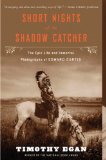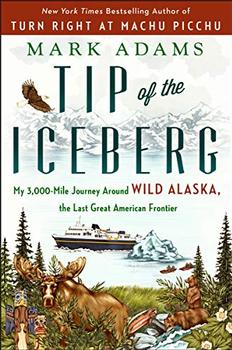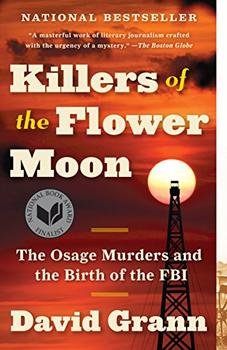Summary | Excerpt | Reading Guide | Reviews | Beyond the book | Read-Alikes | Genres & Themes | Author Bio
The Epic Life and Immortal Photographs of Edward Curtis
by Timothy Egan

Critics' Opinion:
Readers' Opinion:
First Published:
Oct 2012, 384 pages
Paperback:
Aug 2013, 384 pages
 Book Reviewed by:
Book Reviewed by:
Jo Perry
Buy This Book
Timothy Egan's robust biography of Edward Curtis is not only the record of a prophetic artist's life and work, it is a transfixing story of audacious achievement and massive commercial failure during a period of stunning cultural blindness and injustice. Curtis began his career as a society photographer, but is arguably best remembered for his work capturing the lives of Native Americans on film. Egan's portrait of Curtis, who produced an historic twenty-volume photographic and cultural record of America's native peoples, is a masterful and ironic double-exposure: Curtis's life comes into sharpest focus against the backdrop of indigenous America's fading world. As Native Americans and their cultures vanished, Curtis doggedly realized his project which itself was forgotten and almost permanently lost.
 Curtis was an adventurer, a tough and intrepid outdoorsman, and, at the peak of his success, the photographer of America's rich and famous. But Curtis was not an art-school-trained insider like Annie Liebovitz. Egan presents a self-invented genius born in poverty whose vision was shared by only a handful of people during his lifetime. Though he was good at selling himself and working the system, Curtis looked at the world with an outsider's eye.
Curtis was an adventurer, a tough and intrepid outdoorsman, and, at the peak of his success, the photographer of America's rich and famous. But Curtis was not an art-school-trained insider like Annie Liebovitz. Egan presents a self-invented genius born in poverty whose vision was shared by only a handful of people during his lifetime. Though he was good at selling himself and working the system, Curtis looked at the world with an outsider's eye.
Throughout the book, author Timothy Egan outlines the racist stereotypes and attitudes about Native Americans at the time. In the early years of the twentieth century, for example, they were regarded as less than fully human and their religious practices were illegal. Curtis grasped their diffuse and powerful spirituality, read deep emotions in their stoic faces, and intuited the stark oppositions of light and dark, water, earth, and sky that defined their sacred landscapes. It is interesting that Curtis was at the height of his success as a society photographer when he turned to his first Native American subject, an indigent and battered Native American woman who would change his life:
"The city was named for the old woman's father, though the founders had trouble pronouncing See-ahlsh, a kind of gutteral grunt to the ears of the midwesterners . . . Nor could they fathom how to properly say Kick-is-om-lo, his daughter. So the seaport became Seattle . . . and the eccentric Indian woman was renamed Princess Angeline, the oldest and last surviving child of the chief of the Duwamish and Suqamish . . . 'Princess'; was used in condescension . . . How could this dirty, toothless wretch living amid the garbage be royalty? How could this tiny beggar in calico, bent by time, this clam digger who sold bivalves door to door, this laundress who scrubbed clothes on the rocks, be a princess?"
When Curtis took Princess Angeline's picture (see image in backstory), a treaty had swindled her people of their land, removed them to a small and remote reservation, and made it unlawful for Indians to live within Seattle's city limits. Still she remained a "a pet of the city," a representative of "a poor, degraded race." Curtis paid her a dollar for her portrait, and, employing his method of getting "as close as he could," produced an almost confrontational image of a time-battered "face that could knock a door down with its slit-eyed stare." Later photographs of Angeline - "The Princess," "The Clam Digger," and "The Mussel Gatherer – transform her from a tough survivor into a "noble" and "ageless figure . . . in front of a tranquil bay."
Curtis's rich sepia prints of dump-dweller Angeline - photo-engraved on glass plates and hand-finished on the fine paper he used for his portraits of the wealthy and the famous - began the obsession that would engulf Curtis for the next thirty years and that would deplete most of his physical and entrepreneurial energy. What is important in the Angeline images is also important in the pictures that fill his twenty-volume masterpiece, The North American Indian: lavish, painstaking technique and use of the finest materials assert the stark and austere dignity of the defeated.
Egan traces Curtis's activities in great detail - where he went, who assisted in his great work, how he traveled, what he ate (Curtis liked salmon roasted the Indian way, skin to the fire), what he saw, whom and what he photographed and which rich and powerful person Curtis had to importune for money to keep the project going. There are adventures, close scrapes, and displays of raw physical courage as when Curtis took part in the secret and dangerous Hopi snake dance ritual.
Egan organizes his narrative around the research and completion of each of the twenty volumes comprising The North American Indian - the tribe or tribes Curtis got to know, recorded through camera, sound recordings, and detailed notes on language, customs, religion, diet, and songs. Curtis's resolve, his physical prowess, his patience, and the magnitude of his ambition are thrilling. The humiliation, betrayal, and torture suffered by the Native Americans Curtis documented and whose personal accounts he recorded will leave readers sickened and ashamed. The inclusion of many of Curtis's photographs in the book (in black and white, not Curtis's rich sepia) lets the reader experience his work directly, but I would have liked more information on his photographic techniques.
If there is a weakness in Egan's narrative, it is that I closed the book knowing more about Curtis's work than about the man himself. But perhaps the absence of information on Curtis's inner life isn't his biographer's fault. Curtis spent his life working - seven days a week and sixteen hours a day, decade after decade after decade, except for a few periods when exhaustion slowed him down. Despite the almost breathtaking scope of Curtis's commercial failures, the collapse of his marriage and the world's absolute indifference, he went on to produce the very first documentary film about Native Americans, to invent a machine for dredging gold, and cruel irony among a life of bitter ironies, to become a Hollywood still photographer.
The great fantasy or idea that pulled Curtis toward an outlaw culture in the first place, and the source of his absolute devotion to the staggering task of completing "the largest anthropological work ever undertaken" remain, even after Egan's exhaustive exploration, mysterious. Though Curtis knew what he was doing was important, the reader is left without a full sense of what drove him. Perhaps it comes down to something as simple as temperament. With his high-energy mind and body and his passionate love of the outdoors, Curtis might have felt most creative and most fully alive while working in Indian country, a world "full of stories of the days . . . when life was real and full of action." Egan's history of this bold and original man is masterful, moving and important - he does for Curtis what Curtis did for Native Americans: makes the man real.
![]() This review was originally published in The BookBrowse Review in October 2012, and has been updated for the
August 2013 edition.
Click here to go to this issue.
This review was originally published in The BookBrowse Review in October 2012, and has been updated for the
August 2013 edition.
Click here to go to this issue.

If you liked Short Nights of the Shadow Catcher, try these:

by Mark Adams
Published 2019
From the acclaimed, bestselling author of Turn Right at Machu Picchu, a fascinating and funny journey into Alaska, America's last frontier, retracing the historic 1899 Harriman Expedition.

by David Grann
Published 2018
Winner of the 2017 BookBrowse Nonfiction Award
A twisting, haunting true-life murder mystery about one of the most monstrous crimes in American history.





The House on Biscayne Bay
by Chanel Cleeton
As death stalks a gothic mansion in Miami, the lives of two women intertwine as the past and present collide.

The Flower Sisters
by Michelle Collins Anderson
From the new Fannie Flagg of the Ozarks, a richly-woven story of family, forgiveness, and reinvention.

The Funeral Cryer by Wenyan Lu
Debut novelist Wenyan Lu brings us this witty yet profound story about one woman's midlife reawakening in contemporary rural China.
Your guide toexceptional books
BookBrowse seeks out and recommends the best in contemporary fiction and nonfiction—books that not only engage and entertain but also deepen our understanding of ourselves and the world around us.